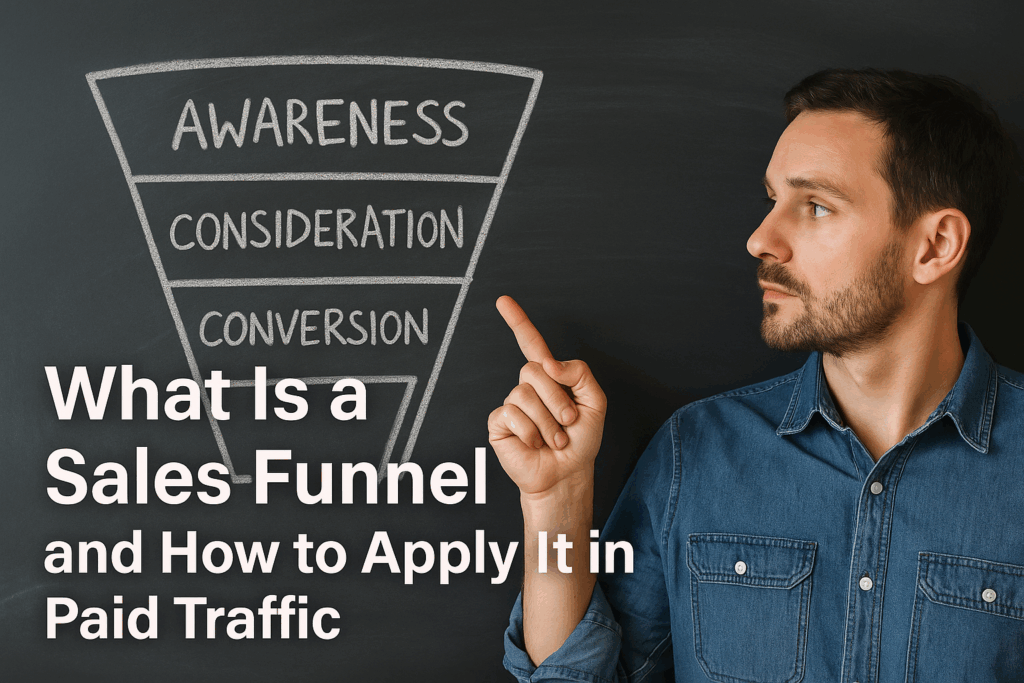If you’re investing in paid Ads on Facebook, Google, Instagram, or anywhere else you’ve probably heard the term “sales funnel”.
But what does it actually mean?
And more importantly: how do you build one that turns ad clicks into real customers?
In this article, we’ll explain what a sales funnel is, why it matters in paid traffic campaigns, and how to apply it step by step—even if you’re just starting out.
What Is a Sales Funnel?
A sales funnel is a step-by-step journey that guides someone from discovering your brand to taking action—like buying your product, booking a call, or joining your email list.
It’s called a “funnel” because many people enter at the top, but only a smaller number convert at the bottom.
The funnel helps you:
- Build trust
- Educate your audience
- Filter out unqualified leads
- Make sales more naturally (and at scale)
The 3 Main Stages of a Sales Funnel
While funnels can get complex, most can be broken into three basic stages:
1. Top of Funnel (TOFU) – Awareness
This is where people discover you for the first time. They may not know your brand—or even that they have a problem yet.
Your goal: educate and attract attention.
✅ Examples of TOFU content:
- Blog posts
- Free videos or tips
- Entertaining or emotional ads
- “Problem-aware” messaging
Best ad objective: Reach, Video Views, Engagement, or Website Traffic
2. Middle of Funnel (MOFU) – Consideration
Now they know who you are—and they’re interested.
They’re comparing options or looking for more information.
Your goal: build trust and offer value.
✅ Examples of MOFU content:
- Lead magnets (free PDFs, checklists, templates)
- Webinars or mini-trainings
- Testimonials or case studies
- Product demos
Best ad objective: Lead Generation, Landing Page Views, or Messages
3. Bottom of Funnel (BOFU) – Conversion
This is where they’re ready to take action—but might need a final nudge.
Your goal: convert and close the sale.
✅ Examples of BOFU content:
- Sales pages
- Discount or urgency offers
- Strong social proof
- Retargeting campaigns
Best ad objective: Conversions, Purchases, or Booked Appointments
Why Funnels Matter in Paid Ads
Most ad campaigns fail because they try to sell too fast.
They show an ad asking for a sale to a cold audience who’s never heard of the brand—and then wonder why no one buys.
Funnels fix this by:
- Warming people up gradually
- Matching the right message to the right moment
- Reducing ad fatigue
- Improving your ROI (because people convert when they’re ready)
How to Apply a Sales Funnel in Your Paid Traffic Strategy
Step 1: Map Your Funnel
Start by answering:
- What’s your offer? (product, service, course, etc.)
- Who is your audience?
- What do they need to believe or know before buying?
Then sketch a simple flow:
Ad → Landing Page → Free Offer → Email Follow-Up → Sales Page
Even simple funnels like this work really well when done right.
Step 2: Create Funnel-Specific Ads
Each funnel stage should have a different ad style and message.
TOFU Ads:
- “Here’s a tip no one talks about…”
- “Watch how we solved [common problem]”
- Format: short video, carousel, or relatable story
MOFU Ads:
- “Download our free guide to [solve X]”
- “Watch how Sarah got results with this tool”
- Format: case study, lead magnet, webinar teaser
BOFU Ads:
- “Still thinking about it? Here’s what others say…”
- “Only 3 spots left—book your call today”
- Format: testimonial-based creative, urgency offer, limited-time discount
Step 3: Use Retargeting at Each Stage
Not everyone will convert on the first click. Retargeting helps move them forward.
Examples:
- Retarget TOFU viewers with MOFU lead magnet
- Retarget email subscribers who didn’t buy
- Retarget landing page visitors with a “last chance” offer
Platforms like Meta and Google allow precise audience building with pixels and tags—use them wisely.
Step 4: Add Email or SMS Follow-Up
Ads are powerful—but most conversions happen after the click.
Always capture emails or phone numbers where possible, and follow up with:
- Nurture sequences
- Value-packed content
- Testimonials and case studies
- Special offers
This keeps your funnel working in the background—day and night.
Funnel Example: Digital Course Launch
Let’s say you’re launching a course on freelance writing.
TOFU:
- Video ad: “How I got my first freelance client in 7 days”
- Traffic goes to a blog post or video
MOFU:
- Lead magnet: “Free 5-day writing client challenge”
- Leads enter your email list
BOFU:
- Retargeting ad: “Last chance to join the course—bonus ends tonight!”
- Leads to a sales page with testimonials
Boom: complete funnel using paid traffic.
Final Thoughts: Funnels Make Ads Work Smarter
If your paid ads aren’t converting, don’t assume the platform is the problem.
Look at your funnel.
Are you rushing the sale? Sending cold traffic to hot offers? Ignoring retargeting?
When you apply a sales funnel to your traffic strategy, you stop relying on luck—and start building a system that warms, nurtures, and converts your audience step by step.
